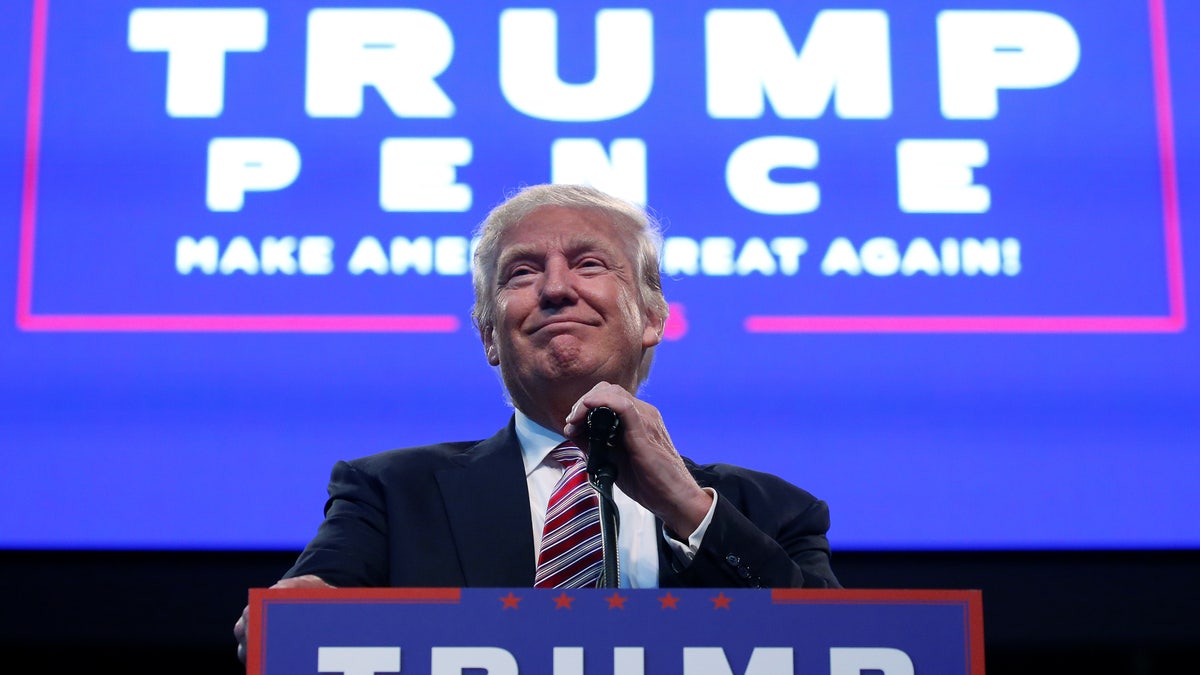
A man holds an "I Love Trump" sign along the perimeter walls of the 2016 Democratic National Convention in Philadelphia, Pennsylvania on July 27, 2016. (REUTERS/Adrees Latif)
The battle is on. The Republican National Convention is in the rearview mirror, the Democratic one is nearing its end, and there are just over 100 days until the presidential election.
Both the major candidates are leveraging tech and social media to reach voters, but they have notably different styles. And Hillary Clinton’s campaign took the battlefield to the Apple app store recently, releasing an interactive new app called “Hillary 2016.”
The polished app asks users to complete tasks like watering a virtual plant in a virtual campaign headquarters, pledging to vote for Clinton, or even taking a true-or-false quiz called “Trump or False” in which a user has to choose whether or not a statement was actually uttered by Trump. The app also includes a way to follow campaign news and donate to it.
Trump’s campaign does not appear to have an official app, and a Trump representative did not reply to an inquiry from FoxNews.com about the topic.
Both Clinton and Trump reach the public via relatively traditional new-media channels including Twitter, Facebook, YouTube, and Instagram. On Twitter, Trump reaches millions more followers, and on Instagram, he reaches thousands more. Trump also greatly surpasses Clinton on Facebook, with roughly twice as many “likes” on his official page.
The two have vastly different Twitter styles, though. Trump is well known for his bombastic Twitter voice. His tweets are heavy on the exclamation points, and include insults like calling Vice President Joseph Biden “not very bright.” The candidate has also sparked controversy for tweeting that if Russia has emails from Clinton’s controversial private email server from her time as Secretary of State, they should turn them over.
Clinton’s Twitter account, while it has fewer followers, presents as more polished, and was recently filled with tweets quoting President Obama’s speech at the DNC. She also makes use of two digital platforms— Medium and Pinterest— that Trump does not appear to use.
Jason Mollica, the president of JRM Comms, a public relations and marketing firm, said that in general, it makes sense for a brand— or a political candidate in this case— to think about how to best reach their target demographic. That’s why it’s natural for Clinton to use Pinterest, which attracts women aged 25-55, he said.
As for Trump, Mollica said that the Republican candidate already has a well-establish social media presence, and might not feel the need to look for other channels.
“People are drawn to him on his social networks to see what thing he’s going to say next,” he told FoxNews.com, “whether it’s crazy, or whether it’s actually something that is relevant and really sticks to an issue per se, instead of just saying ‘that person’s an idiot.”
On the Democratic side, Mollica praised the use of the Twitter hashtag #ImWithHer, which he called “a very smart and tactical hashtag” that can represent both supporting Hillary and women generally.
“My perspective is that Mrs. Clinton has done a far better job at engaging her audience on social networks than Mr. Trump,” he said.
Fired up, ready to go! pic.twitter.com/NM890pAtL7
— Hillary Clinton (@HillaryClinton) July 28, 2016
Common Trump hashtags include #AmericaFirst, #MakeAmericaSafeAgain, #ImWithYou, and #CrookedHillary. Meanwhile, Clinton last week rolled out a service called #TrumpYourself.
Mollica said that in the social media landscape, audience sharing is more important than the number of followers. As an example, he pointed to a June tweet from Clinton that he described as the campaign season’s most-shared tweet:
Delete your account. https://t.co/Oa92sncRQY
— Hillary Clinton (@HillaryClinton) June 9, 2016
That tweet, in which Clinton responded to one of Trump’s tweets, read simply: “Delete your account.” It was retweeted over 482,000 times.
Follow Rob Verger on Twitter: @robverger
